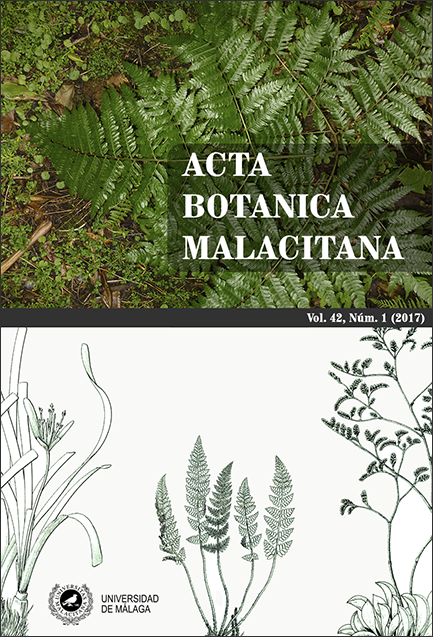Diversity and endemism of tree ferns (Cyatheaceae: Polypodiopsida) in the Central Andes along latitudinal and elevation gradients
DOI:
https://doi.org/10.24310/abm.v42i1.2959Resumen
Tree ferns are a conspicuous and yet poorly known component of Neotropical montane forests. Conservation efforts for these plants are hindered by a lack of information of patterns of species richness and endemism, which has been in turn prevented by an unstable taxonomy and limited collections. Based on distribution data from the most recent floristic accounts of tree ferns from Peru, Bolivia, and Argentina, this study presents an analysis of species richness and endemism of this group in the Central Andes. Results show that tree fern diversity falls steeply with distance from the equator, and the effect is stronger in the lowlands than at tree line to -20°. In elevation, tree fern species richness shows a bimodal distribution with peaks at 1000 and 2100 m, where as many as 24 species can coexist in 200 m elevation intervals. Endemic species are concentrated in the northern Central Andes. Endemics in more southern latitudes tend to be restricted to higher elevations. Correspondingly, the tree fern flora of the southern Central Andes is mostly composed of widely ranging species, potentially tolerant of higher seasonality and longer term climatic fluctuations. These results provide a tool for predicting how many tree fern species should be found in any given area of the Central Andes, even those botanically unexplored, and indicates areas where species richness and endemism is concentrated, and may serve to guide efforts aimed to conserve tropical montane forests.
Descargas
Métricas
Citas
Balslev, H. (1988). Distribution patterns of Ecuadorean plant species. Taxon, 37, 567–577.
Baltzer, J. L., Davies, S. J., Bunyavejchewin, S., & Noor, N. S. M. (2008). The role of desiccation tolerance in determining tree species distributions along the Malay–Thai Peninsula. Functional Ecology, 22, 221– 231.
Bjorholm, S., Svenning, J.C., Baker, W.J., Skov, F., & Balslev, H. (2006). Historical legacies in the geographical diversity patterns of New World palm (Arecaceae) subfamilies. Botanical Journal of the Linnean Society, 151, 113-125.
Feeley, K. J., Silman, M. R. (2011). The data void in modeling current and future distributions of tropical species. Global Change Biology, 17, 626–630.
Garreaud, R. D. (2009). The Andes climate and weather. Advances in Geosciences, 22, 3–11. http://www.adv- geosci.net/22/3/2009/adgeo-22-3-2009.pdf
Gentry, A.H. (1988). Changes in plant community diversity and floristic composition on environmental and geographical gradients. Annals of the Missouri Botanical Garden, 75, 1–34
Goodwin, Z. A., Harris, D. J., Filer, D., Wood, J. R. & Scotland, R. W. (2015). Widespread mistaken identity in tropical plant collections. Current biology, 25, 1066– 1067. doi: 10.1016/j.cub.2015.10.002.
Hammer, Ø., Harper, D.A.T., & Ryan, P.D. (2001). PAST: Paleontological statistics software package for education and data analysis. Palaeontologia Electronica, 4(1), 1–9.
Kessler, M. (2000). Altitudinal zonation of Andean cryptogam communities. Journal of Biogeography, 27, 275–282.
Kessler, M., Parris, B.S. & Kessler, E. (2001). A comparison of the tropical montane pteridophyte floras of Mount Kinabalu, Borneo, and Parque Nacional Carrasco, Bolivia. Journal of Biogeography, 28(5), 611–622.
Kessler, M., Kluge, J., Hemp, A., & Ohlemuller, R. (2011). A global comparative analysis of elevational species richness patterns of ferns. Global Ecology and Biogeography, 20, 868–880.
Killeen, T.J., Douglas, M., Consiglio, T., Jørgense, P.M., & Mejía, J. (2007). Dry spots and wet spots in the Andean hotspot. Journal of Biogeography (Special issue), 1–17.
Kluge, J., Kessler, M. & Dunn, R.R. (2006). What drives elevational patterns of diversity? A test of geometric constraints, climate and species pool effects for pteridophytes on an elevational gradient in Costa Rica. Global Ecology and Biogeography, 15, 358. https://www.researchgate.net/profile/Michael_ Kessler/publication/229682551
Kreft, H., Jetz, W., Mutke, J., Barthlott, W. (2010). Contrasting environmental and regional effects on global pteridophyte and seed plant diversity. Ecography, 33, 408–419. http://www.uni-goettingen. de/de/document/download/3bfe88977d84edb99e5e9 584c9.
Large, M. F. & J. E. Braggins. (2004). Tree Ferns. Portland/Cambridge: Timber Press.
Lehnert, M. (2006). The Cyatheaceae and Dicksoniaceae (Pteridophyta) of Bolivia. Brittonia, 58, 229–244.
Lehnert, M. (2011). The Cyatheaceae (Polypodiopsida) of Peru. Brittonia 63, 11–45.
Lehnert, M., & Tejedor. A. (2016). Three new scaly tree fern species ( Cyathea -Cyatheaceae) from the Amotape-Huancabamba Zone and their biogeographic context. American Fern Journal, 106(3), 175-190.
Márquez, G. J. (2010). La familia Cyatheaceae (Pteridophyta) en la Argentina. Boletin de la Sociedad Argentina de Botánica, 45(1-2), 173–182.
Martínez, O. G. (2014). A new species of Alsophila (Cyatheaceae) from the Tucuman-Bolivian forest. Brittonia, 67(1), 48–55.
Morin, X., & Chuine, I. (2006). Niche breadth, competitive strength and rangesize of tree species: a trade-off based framework to understand species dis-tribution. Ecology Letters, 9, 185–195.
Mutke J, Barthlott W. (2005). Patterns of vascular plant diversity at continental to global scales. Biologiske Skrifter, 55, 521–531.
Possingham, H. P., Wilson, K. A., Andelman, S.J., & Vynne, C. H. (2006). Protected Areas: Goals, limitations and designs. In M. J. Groom, G. K. Meffe, & C. R. Carroll (Eds.) Principles of Conservation Biology. 3rd ed. (pp 509–533). Sunderland, MA: Sinauer Associates, Inc.
Ramírez-Barahona, S., Luna-Vega, I., Tejero-Díez, D. (2011). Species richness, endemism, and conservation of American tree ferns (Cyatheales). Biodiversity and Conservation, 20(1), 59–72. DOI 10.1007/s105319946-2.
Ramírez-Barahona S, Barrera-Redondo J, Eguiarte LE. (2016). Rates of ecological divergence and body size evolution are correlated with species diversification in scaly tree ferns. Proceedings of the Royal Society B, 283, 20161098. DOI 10.1098/rspb.2016.1098.
Rapp, J.M. (2010). Climate Control on Plant Performance Across an Andean Altitudinal Gradient. PhD Dissertation Wake Forest University.
Salazar, L., Homeier, J., Kessler, M., Abrahamczyk, S., Lehnert, M., Krömer, T., & Kluge, J. (2013). Diversity patterns of ferns along elevational gradients in Andean tropical forests. Plant Ecology and Diversity. http:// dx.doi.org/10.1080/17550874.2013.843036
Smith, A., Pryer, K. M., Schuettpelz, E., Korall, P., Schneider, H., & Wolf, A. (2008). Fern classification. In T. A. Ranker & C. H. Haufler (Eds.) The biology and evolution of ferns and lycophytes. (pp. 107–133). Cambridge, UK: Cambridge University Press.
Smith, A. R., Leon, B., Tuomisto, H., Van Der Werff, H., Moran, R. C., Lehnert, M. & Kessler, M. (2005). New records of pteridophytes for the flora of Peru. Sida, 21, 2321–2342.
Sosa et al. (2016), Historical reconstruction of climatic and elevation preferences and the evolution of cloud forest-adapted tree ferns in Mesoamerica. PeerJ, 4:e2696; DOI 10.7717/peerj.2696
Wang, H, & Fu, R. (2002). Cross-equatorial flow and seasonal cycle of precipitation over South America. Journal of Climate, 15, 1591–1608. http://journals.ametsoc.org/doi/pdf/10.1175/1520- 0442%282002%29015%3C1591.
Descargas
Publicado
Cómo citar
Número
Sección
Licencia
Toda la información relacionada con la licencia de uso de los trabajos publicados en Acta Botanica Malacitana y con los derechos de autor se pueden consultar en nuestra Política Editorial.







1.png)


